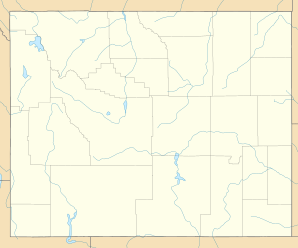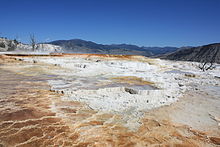Mammoth Hot Springs
| Mammoth Hot Springs | ||
|---|---|---|
 Mammoth Hot Springs |
||
| Location in Wyoming | ||
|
|
||
| Basic data | ||
| State : | United States | |
| State : | Wyoming | |
| County : | Park County (Wyoming) | |
| Coordinates : | 44 ° 59 ′ N , 110 ° 42 ′ W | |
| Time zone : | Mountain ( UTC − 7 / −6 ) | |
| Height : | 1902 m | |
| Postal code : | 82190 | |
| Area code : | +1 307 | |
| GNIS ID : | 1609273 | |
 Overview of the terraces |
||
Mammoth Hot Springs is the main and administrative center of Yellowstone National Park in the USA . It owes its name to the nearby sinter terraces and hot springs . It is located at 1902 m. ü. M.
In addition to the administration buildings, the village consists only of a restaurant, a hotel, a souvenir shop, a gas station, a chapel, a post office and a few houses and huts for employees and tourists.
Geographical location
Mammoth Hot Springs is the northernmost location of the national park, near the northern entrance and in Wyoming right on the border with Montana .
Roads lead to the two villages of Tower-Roosevelt (approx. 29 km) and Norris (approx. 34 km) within the park and to Gardiner , a neighboring village outside the park.
history
The sinter terraces and hot springs at Mammoth Hot Springs were officially discovered in 1871 by a geological expedition under Ferdinand V. Hayden . In the same year the gold prospector Harry Horr named the sources. Before Hayden came across them, they must have been known to some Indian peoples.
Fort Yellowstone was built between 1891 and 1913 near Mammoth Hot Springs . The US troops stationed at the fort were responsible for the administration and management of the national park until the National Park Service was founded on August 30, 1916. In 1918 the National Park Service finally took over administration. The fort was converted into a civil administration agency. The park is still managed from Mammoth Hot Springs today.
Some of the buildings in Mammoth Hot Springs are quite old, for example the hotel was built in 1937, one wing of which was built in 1911.
Sintered terraces
Hot springs let warm water of approx. 70 ° C slide over the terraces. The water contains above-average proportions of lime and minerals , which precipitate at the source and are deposited in the form of terraces. The arrangement of the terraces depends on the type of deposits and the growth rate of the minerals as well as on the direction of flow and the water turbulence. Algae and bacteria settle in the resulting shallow basins; depending on the temperature of the water, these have different colors. Due to the ever new deposits, the direction of flow of the water and thus the temperature and thus the colors - from white to blue, brown, green, yellow, orange or red - of the terraces changes from year to year.
The water flows down from the surrounding slopes, is heated underground by volcanic activity and swells to the surface at Mammoth Hot Springs. Sulphurous gases often escape . The water flow has leveled off at about 500 gallons (about 1900 liters) per minute. At the bottom, the water seeps away. Visitors are led through the terraces on wooden walkways, as the floor cannot be stepped on everywhere and so as not to endanger the terraces.
The terraces began to form millions of years ago. Today the water deposits up to two tons of limestone per day.
Similar sintered terraces can be found in the Turkish town of Pamukkale . Similar sintered terraces also existed in New Zealand , but they were destroyed by volcanic activity in 1886.
Attractions
Herds of elk is common in the Mammoth Hot Springs area . They like to lie on the warm sintered terraces in the morning and in the evening. A herd has made its home in the village for a number of years, which is why some shops have secured their flower boxes with grids against wild damage .
The sinter terraces include a number of well-known springs, terraces and rocks:
|
Mount Everts is located slightly east of Mammoth Hot Springs .
Web links
- National Park Service: Mammoth Hot Springs (Engl.)
- National Park Service: FAQ (Engl.)
Individual evidence
- ^ Aubrey L. Haines: The Yellowstone Story - A History of our First National Park . University Press of Colorado, Niwot 1996. Volume 1, p. 144
- ↑ Yellowstone National Park.com: Mammoth (October 5, 2008)
- ↑ Engineering at Illinois: Watching rocks grow: Theory explains landscape of geothermal springs





